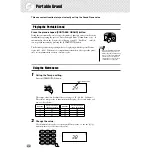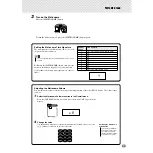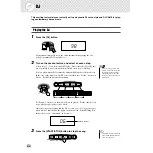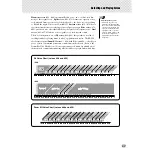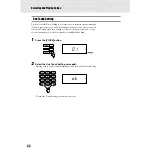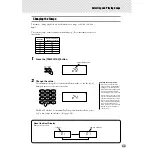
Selecting and Playing Voices
26
There are two ways to select voices: 1) directly entering the voice number
with the numeric keypad, or 2) using the [+]/[–] buttons to step up and down
through the voices.
■
Using the numeric keypad
Enter the digits of the voice number as printed on the panel. For example, to
select voice #42, press “4” on the numeric keypad, then “2.” For voice num-
bers beginning with zeroes (such as #06), the initial zeroes may be omitted.
In this case, there is a short pause before the indication appears.
■
Using the [+]/[–] buttons
Press the [+] button to select the next voice number, and press the [–] button
to select the previous voice. Holding down either key continuously scrolls
up or down through the numbers.
3
Play the selected voice.
42
• Each voice is automatically
called up with the most suitable
octave range setting. Thus, play-
ing middle C with one voice may
sound higher or lower than
another voice at the same key.
• Four of the Organ voices are
effect “pairs.” Switching between
each of the paired voices (with
the [+]/[–] buttons) turns the
effect of the voice on or off. For
example, for the Vibrato pair (#10
and #11), selecting #10 turns the
vibrato effect off, while selecting
#11 turns vibrato on. The same
applies to the Harmony, Attack
and Wave voices (#12 - #17).
• You can select the One Touch
Setting Voice (
ot
) by pressing
both [+]/[–] buttons simulta-
neously. (See page 28.)
• The EZ-150 is polyphonic up to a
maximum of 16 notes. (Depend-
ing on the voice selected — such
as split voices and dual voices —
fewer notes may be available.)
This includes not only the notes
played from the keyboard, but
also the notes in a style pattern,
the notes played by a Pad (page
53), and so on. Thus, if you play
too many notes at one time,
some may not sound and/or oth-
ers may be cancelled.











